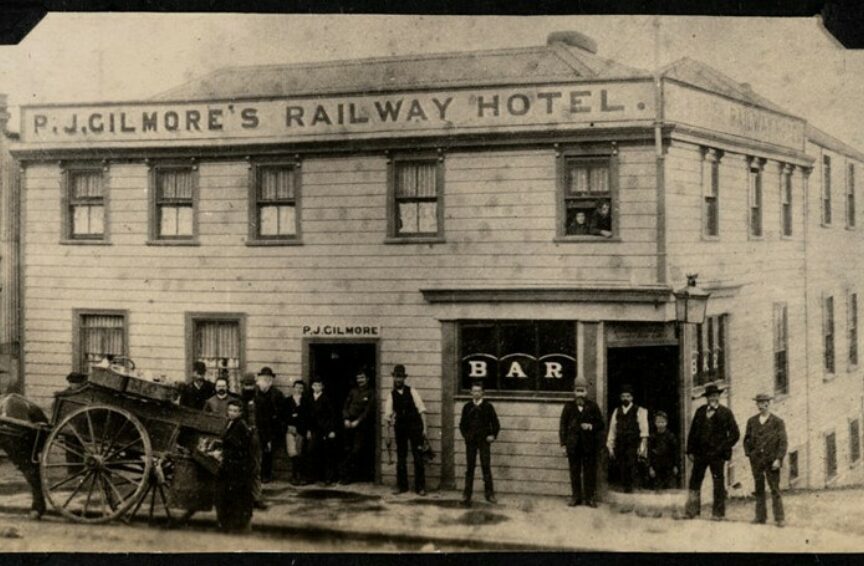PO Box 95
Lyttelton 8841
Te Ūaka recognises Te Hapū o Ngāti Wheke as Mana Whenua and Mana Moana for Te Whakaraupō / Lyttelton Harbour.
The Demise of the Mighty Mitre
Over recent weeks residents of Ōhinehou Lyttelton have been observing Frews Contracting's 'bite by bite' demolition of the historic Mitre Hotel on Norwich Quay with mixed responses. In recognition of the significance of the building it seems fitting to highlight this very early image of the original Mitre Hotel, named, along with the Quay it flanked, after the Anglican Bishopric of Norwich.
The dark two storey timber building visible in the centre of the 1865 image is the first Mitre Hotel, an initiative by Major Alfred Hornbrook to replace the unlicensed temporary premises that he had been operating there alongside a boatbuilder and sailmaker. Ideally situated near the waterfront and at the base of the Bridle Path, it became an important refreshment and meeting spot for new migrants in the wave of the Canterbury Association’s planned settlement, which began in earnest with the arrival of 'The First Four Ships' in 1850.
The large three storey stone structure flanking the waterfront is the1864 Hargreaves building, adjacent to Heywood's Store. The 1861 Lyttelton Methodist (or Wesleyan) Church is visible above the roofline of the Mitre Hotel. Sheet piling evident in front of that structure was intended to protect the foreshore. The image itself appears to be taken from the vantage point of the 'Government Jetty’ (also known as Thomas's Jetty), the first to be built in this location.
In April 1850, John Robert Godley, Canterbury Association Founder, admired the Mitre Hotel on his arrival in Lyttelton and was impressed by it and other facilities in the fledgling European settlement. Integral to the port's activities, ship's labourers or 'lumpers' would wait at the Mitre to be hired and paid. Land and property sales, postal services, public meetings, company and society AGMs, inquests and all manner of events were held within its walls, including a dinner to celebrate Queen Victoria's birthday in 1851. The “Lyttelton Times” was regularly sprinkled with reports of licensing breaches by publicans or barmaids and incidents of a more or less serious nature, some but not all involving 'intoxicating liquor'.
In 1870 Lyttelton's 'Great Fire' decimated most of the central and commercial heart of the township. Savvy action by the Mitre's publican in rallying seamen to create a bucket brigade, using beer from the hotel's barrels to douse the Mitre's shingled roof, saved the building from the ashen fate of many others. Ironically, just five years later in August 1875 the first Mitre Hotel was totally lost to fire.
A new hotel designed by architect and engineer John Sigismund Jacobsen used native timbers with a gracious recessed second storey balcony, curved parapet and substantial entrance opening onto Norwich Quay. Proprietor RJ Henry proudly advertised “First-class accommodation at moderate prices” and “Every modern convenience”. Our second photograph shows this fine building at the turn of the century. Amongst numerous other goings-on, in 1910 Captain Scott's farewell dinner was held in the ballroom, prior to his departure on the British Antarctic Expedition aboard the Terra Nova, which would end so tragically.
Sadly, the second Mitre also fell victim to fire. Primarily fuelled by coal, Lyttelton's airspace was a distinctly smoggy one in those days, and fireplace and chimney fires were common. It is likely those causes were behind a fire in 1925, which caused extensive damage to the timber building. Repairs were still being undertaken when the building was completely gutted in yet another conflagration in March 1926.
As a consequence of this fire, the Licensing Board requested a change in materials for the third Mitre Hotel. Built in 1926 for licensee Charles Percy Cameron (the Cameron family having owned the hotel since the late 1870s), it was an imposing structure of brick and reinforced concrete, intended to withstand fire. The new hotel’s open balcony, curved parapet and grand entrance referenced its timber predecessor, albeit with an art deco flavour not seen in the pre-war period of the earlier building.
The non timber construction served its purpose in the face of Lyttelton's second great fire of Christmas Eve 1942, which began in Rhinds Grain Store along Norwich Quay. This time, although some neighbouring buildings were total losses, the impact on the Mitre was restricted to shattered windows, scorched walls and some internal damage.
The Mitre continued to provide public house facilities and first floor accommodation right through to the 1960s. In the 1970s the New Zealand Breweries (later Lion Nathan Ltd) took over ownership, and a distinctive brown ale beer bottle adorned with a bishop's mitre hat came into use; no doubt a sought after collection item for those inclined to such pursuits. Purchased by the current owners in 2005 and badly damaged in the earthquakes of 2010 and 2011, the building was deemed uneconomic to repair; despite efforts it did not attract heritage funding for the significant costs to save it.
Love it or loathe it, the demolition of the Mitre marks a significant loss to what little remains of colonial architecture in Ōhinehou Lyttelton. That the current Mitre has 'hung on' so long is probably testament to its monolithic construction. Its demise means the British Hotel on the corner of Oxford Street and Norwich Quay has the poignant honour of being the only remaining traditional hotel building in Lyttelton. The Mitre Hotel site remains important as Canterbury's first commercial and licensed premises and for playing host as watering hole, accommodation provider and local community gathering spot for over 160 years.

